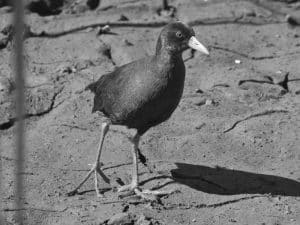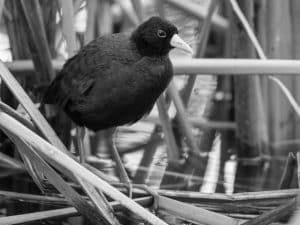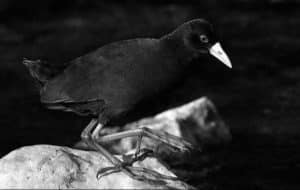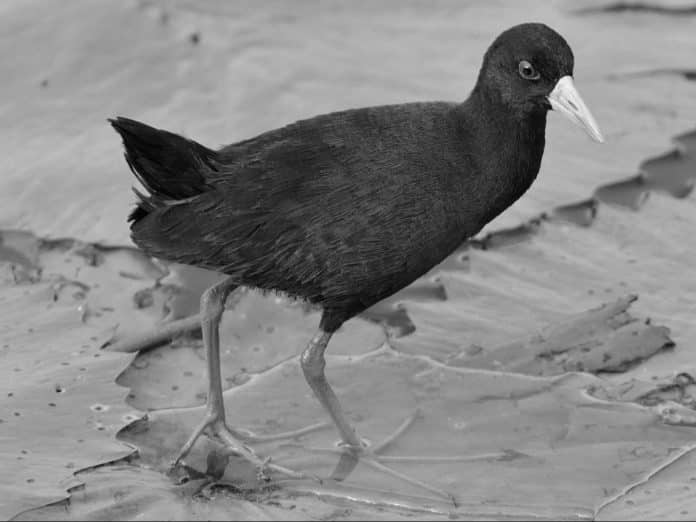Introduction to the Black Crake in Tanzania
The black crake (Amaurornis flavirostris) is a fascinating bird species that can be found in the beautiful country of Tanzania. With its striking black plumage and bold red eyes, the black crake in Tanzania stands out among the wetlands it calls home. In this article, we will explore the habitat, physical characteristics, behavior, breeding habits, diet, and conservation status of the black crake in Tanzania. We will also provide tips on where and how to spot these marvelous birds in the wild, as well as the importance of appreciating and protecting them.
Habitat and Distribution of the Black Crake

The black crake is predominantly found in the wetlands and marshes of Tanzania, where it forages for food and builds its nests. These wetlands provide the perfect combination of water, reeds, and vegetation that the black crake requires to thrive. From the vast Serengeti National Park to the famous Selous Game Reserve, Tanzania offers a diverse range of wetland habitats that support populations of black crakes.
While the black crake is primarily distributed across Tanzania, it can also be found in other parts of Africa, including Kenya, Uganda, and Zambia. However, each population may have distinct characteristics and adaptations based on the specific wetland ecosystems they inhabit. Understanding the habitat and distribution of the black crake is crucial for conservation efforts and ensuring the long-term survival of this species.
Physical Characteristics and Behavior of the Black Crake
The black crake is a small bird, measuring around 22 to 25 centimeters in length and weighing approximately 70 to 90 grams. Its plumage is predominantly black, with a glossy sheen that reflects light beautifully. The bird’s most striking feature is its vibrant red eyes, which are in stark contrast to its dark feathers. These eyes are not only visually captivating but also serve a functional purpose, allowing the black crake to see clearly during both day and night.
In terms of behavior, the black crake is known for its agile and secretive nature. It is an excellent swimmer and diver, navigating through the wetlands with ease. The black crake is also a skilled forager, feeding on a variety of aquatic invertebrates, small fish, and even amphibians. It is a territorial bird and can often be heard emitting loud calls to mark its presence and defend its territory from intruders.
Breeding and Nesting Habits of the Black Crake

Breeding season for the black crake in Tanzania typically occurs during the rainy months, when wetlands are at their peak productivity. The male black crake performs an elaborate courtship display to attract a mate, which includes bowing, fluffing its feathers, and calling loudly. Once a pair has formed, they will build a nest together, weaving reeds, grasses, and other vegetation into a floating platform amidst the dense vegetation of the wetlands.
The female black crake will lay a clutch of 3 to 6 eggs, which both parents take turns incubating for approximately 18 to 20 days. After hatching, the chicks are cared for by both parents, who diligently feed and protect them until they are ready to fledge. The black crake’s nesting habits are an important part of its life cycle, contributing to the growth and sustainability of its population in Tanzania.
Diet and Feeding Behavior of the Black Crake
The black crake has a diverse diet, primarily consisting of aquatic invertebrates such as insects, crustaceans, and mollusks. It is also known to feed on small fish, frogs, tadpoles, and even the eggs of other wetland birds. The black crake employs various feeding techniques, including pecking, probing, and gleaning. Its long, slender bill is perfectly adapted for capturing and consuming its prey, allowing it to navigate through the dense vegetation of the wetlands with ease.
To forage for food, the black crake will walk along the edges of water bodies, delicately balancing on floating vegetation or wading through shallow waters. It will use its bill to search for hidden prey, frequently darting it into the water or mud to catch unsuspecting invertebrates. The black crake’s feeding behavior is not only essential for its survival but also plays a vital role in maintaining the delicate balance of the wetland ecosystem.
Threats and Conservation Status of the Black Crake in Tanzania
Despite its adaptability and resilience, the black crake faces several threats to its survival in Tanzania. One of the primary threats is the destruction and degradation of its wetland habitat due to human activities such as agriculture, urbanization, and pollution. These activities not only reduce the available nesting and foraging areas for the black crake but also disrupt the delicate balance of the wetland ecosystem.
Additionally, the black crake is hunted for food and captured for the illegal pet trade in some regions of Tanzania. This unsustainable exploitation further diminishes the population of these birds. Climate change also poses a significant threat, as it leads to alterations in rainfall patterns and water availability, directly impacting the black crake and its wetland habitat.
Conservation Efforts and Initiatives for the Black Crake in Tanzania

Recognizing the importance of conserving the black crake and its wetland habitat, various organizations and initiatives are working towards their protection in Tanzania. These efforts include the establishment of protected areas, such as national parks and reserves, where the black crake and other wetland species can thrive undisturbed. These protected areas not only provide a safe haven for the black crake but also support the local communities through sustainable tourism and livelihood initiatives.
Education and awareness programs are also crucial for the conservation of the black crake. By informing local communities and visitors about the importance of wetland ecosystems and the need to protect the black crake, these programs foster a sense of stewardship and encourage responsible behavior towards nature. Collaboration between government agencies, conservation organizations, and local communities is vital for the success of these initiatives and the long-term survival of the black crake in Tanzania.
Best Places to Spot Black Crakes in Tanzania
If you’re an avid birdwatcher or simply a nature enthusiast, Tanzania offers some of the best places to spot black crakes in their natural habitat. The Serengeti National Park is a popular destination, renowned for its diverse wildlife and stunning landscapes. The wetlands within the park serve as a haven for black crakes and provide ample opportunities to observe them as they forage, swim, and display their vibrant plumage.
Selous Game Reserve is another prime location for black crake sightings. With its vast network of rivers, lakes, and swamps, this reserve offers a rich and varied wetland ecosystem that supports a thriving population of black crakes. Other notable areas where black crakes can be spotted include Lake Victoria, Ngorongoro Conservation Area, and Tarangire National Park. Remember to bring your binoculars and camera to capture the mesmerizing beauty of these midnight mariners.
Tips for Observing and Photographing Black Crakes in the Wild
Observing and photographing black crakes in the wild can be a rewarding experience. Here are some tips to enhance your chances of a successful encounter:
- Patience is key: Black crakes can be quite secretive and may take some time to reveal themselves. Find a comfortable spot near the wetlands and wait quietly for them to emerge from the dense vegetation.
- Be stealthy: Move slowly and avoid sudden movements or loud noises that could startle the black crakes. Remember, they are naturally wary and might retreat if they sense any disturbance.
- Use camouflage: Wear neutral-colored clothing and try to blend in with the surroundings. This will help you get closer to the black crakes without alarming them.
- Study their behavior: Observe the black crakes from a distance and learn their feeding patterns, movements, and preferred perches. This knowledge will enable you to anticipate their behavior and capture unique moments.
- Opt for early mornings or late afternoons: These are the times when black crakes are most active. The soft lighting during these hours enhances the beauty of their plumage and creates stunning photographic opportunities.
Remember, the welfare of the birds and their habitat should always take precedence over capturing the perfect shot. Respect their space and avoid any actions that could disturb or harm them.
Conclusion: Appreciating and Protecting the Black Crake in Tanzania
The black crake is a remarkable bird that adds charm and vibrancy to Tanzania’s wetland ecosystems. Its striking black plumage, red eyes, and agile behavior make it a captivating species to observe and appreciate. However, the black crake faces various threats, including habitat loss, exploitation, and climate change. It is crucial that we take steps to protect this species and its wetland habitats


































